In the field of CNC turning, surface finish is one of the key indicators to measure the quality of workpieces. It not only affects the appearance of the workpiece, but also has an important impact on its functionality, wear resistance, corrosion resistance, and matching accuracy. Especially in industries such as aerospace, precision instrument manufacturing, and medical equipment that require extremely high processing accuracy, improving the surface finish of CNC turning has become a core task in the processing process.
This article explores proven strategies and practices that machinists and engineers can apply to enhance surface quality and consistency in turned components.
What Is Surface Finish in CNC Turning?
Surface finish refers to the texture and smoothness of a part’s surface after machining. It is typically measured in Ra (roughness average), expressed in micrometers (µm) or microinches (µin). Lower Ra values indicate smoother surfaces.
Optimization and rational use of cutting tools
Optimization of cutting tool materials
The performance of cutting tool materials plays a decisive role in surface finish. Carbide cutting tools have become a common choice for CNC turning due to their high hardness and good wear resistance. When processing materials such as stainless steel and aluminum alloy, YT-type cemented carbide is suitable for semi-finishing and finishing, and can provide good surface quality; while YG-type cemented carbide can enhance its anti-adhesion performance when turning stainless steel after adding TaC or NbC fine grains.
Coated cutting tools are a powerful tool for improving surface finish. TiAlSi coating can greatly increase the hardness of the blade surface, effectively prevent adhesion wear, significantly extend tool life during continuous cutting, and reduce the impact of tool wear on surface finish. For materials with higher hardness, cubic boron nitride (CBN) cutting tools can still maintain good cutting performance at high temperatures, avoid plastic deformation of the cutting tool, and thus ensure the finish of the machined surface.

Fine adjustment of tool geometric parameters
Increasing the rake angle can reduce chip deformation and cutting force, and reduce the degree of work hardening. Generally, it is more appropriate to be between 20° and 30°, but the tool strength must be taken into account to prevent chipping. Properly increasing the back angle to 8° – 10° can reduce the friction between the back face of the tool and the machined surface of the workpiece, and avoid scratches caused by friction affecting the surface finish.
The main rake angle is selected to be 45° – 75° according to the shape of the workpiece, and the radial cutting force is reasonably controlled to prevent the deformation of the workpiece; the secondary rake angle is 8° – 15° to reduce the friction between the secondary cutting edge and the machined surface. The blade inclination angle is selected to be positive during fine machining, which is conducive to chip discharge and avoids chips scratching the machined surface; the radius of the tool tip arc is appropriately increased to 0.5 – 1mm, which can effectively improve the surface roughness. In addition, a reasonable design of the chip breaker (roller) groove, such as a full arc or a straight arc, controls the chip shape and prevents chips from winding and affecting the processing.
Correct use and maintenance of tools
Ensure that the tool is firmly installed and accurately aligned, operate strictly in accordance with the machine tool operating procedures, ensure the accuracy of tool installation, and avoid vibration and processing errors caused by improper tool installation. During the processing, check the tool wear regularly. When the wear of the tool back surface reaches 0.2-0.3mm, replace or sharpen the tool in time to prevent excessive wear from affecting the surface finish.
Accurate optimization of cutting parameters
Reasonable control of cutting speed
The cutting speed has a significant impact on the surface finish. Excessive cutting speed will cause the cutting temperature to rise sharply, aggravate tool wear, produce built-up edge, and thus reduce the surface finish; while too low cutting speed may cause work hardening, which also affects the surface quality. Different tool materials correspond to different reasonable cutting speed ranges. In actual processing, the optimal cutting speed needs to be determined comprehensively based on factors such as workpiece material characteristics, tool type, and machine tool performance.
Scientific determination of feed rate
The feed rate directly affects the cutting marks and surface roughness. During finishing, the feed rate is controlled at 0.06 – 0.12mm / spindle revolution, which can effectively reduce cutting marks and surface roughness. At the same time, the feed rate should be adjusted according to the chip breaking situation. If the chips are difficult to break, the feed rate can be appropriately increased, but it must be ensured that it does not exceed the tool bearing capacity to prevent vibration and tool breakage caused by excessive feed, which will affect the surface finish.
Precise control of cutting depth
The cutting depth should be small during finishing, generally less than 0.5 (radius value) to avoid unstable cutting force due to excessive cutting depth, causing workpiece vibration and deformation, and thus affecting surface finish. In the roughing stage, a larger cutting depth can be selected according to the workpiece allowance and the performance of the machine tool and tool, but it is necessary to ensure that there is enough allowance for subsequent finishing to optimize the surface quality.
Optimization of cooling and lubrication system
Appropriate selection of cooling and lubricating fluid
Cooling and lubricating fluid plays an important role in improving surface finish. For rough turning, emulsion or extreme pressure emulsion can be used. The good cooling performance of emulsion can effectively reduce the cutting temperature. The extreme pressure additives added to the extreme pressure emulsion can form a strong lubricating film under high temperature and pressure to reduce tool wear. For fine turning, sulfurized oil is an ideal choice, which can form a lubricating film on the surface of the workpiece and effectively reduce the surface roughness. For processing with extremely high surface quality requirements, a mixture of carbon tetrachloride and engine oil can be used, but protective measures should be taken.
Efficient use of cooling and lubricating fluid
Ensure that the cooling and lubricating fluid has sufficient flow and pressure to ensure that it can fully cover the cutting area, take away the cutting heat and wash away the chips in time, and play a good cooling and lubricating role. Reasonably adjust the spray direction of the cooling and lubricating fluid to align it with the cutting edge of the tool and the chip formation area to improve the cooling and lubrication effect. At the same time, regularly replace the cooling and lubricating fluid to prevent performance degradation due to mixing with chips and impurities, affecting the surface finish.
Optimization of equipment and processes
Guarantee and optimization of machine tool performance
Select CNC lathes with good rigidity and high precision to ensure the stability of the machine tool during the processing. Regularly maintain the machine tool, check the working status of the transmission system, lubrication system, cooling system and other components, and adjust and replace worn parts in time. For example, regularly replace the machine tool lubricating oil, clean the cooling system filter, ensure the normal operation of each system of the machine tool, and provide a stable processing platform for improving the surface finish. In addition, through the precision calibration and debugging of the machine tool, the error of the machine tool itself can be eliminated and the processing accuracy can be improved.
Optimization of workpiece clamping and positioning
Reasonably select the clamping method and positioning method to ensure that the workpiece is firm and reliable during the turning process to avoid loosening or displacement. For slender shaft workpieces, use a center frame or a follower frame for auxiliary support to reduce the deformation of the workpiece under the action of cutting force; use soft claws for clamping to avoid clamping the workpiece surface. During the clamping process, strictly control the clamping force to prevent the workpiece from being deformed due to excessive clamping force and affecting the surface finish.
Reasonable planning of cutting sequence and tool path
Reasonably plan the cutting sequence and tool path, reduce tool idle travel and frequent reversing, improve processing efficiency and ensure processing stability. In multi-process processing, select the appropriate cutting sequence according to the shape and size of the workpiece. For example, when turning shaft parts with steps, first turn the part with a larger diameter, and then turn the part with a smaller diameter to avoid processing errors caused by improper processing sequence. Optimize the tool path and adopt reasonable cutting strategies, such as down milling, to reduce cutting force fluctuations and improve surface finish.
Reasonable application of heat treatment process
For some materials, proper heat treatment before processing can improve their processing performance and thus improve surface finish. For example, martensitic stainless steel is first tempered after entering the factory to adjust the hardness to an appropriate range (such as HRC25 – HRC30), which can improve the material’s turning processability, make it easier to obtain good surface quality, and reduce tool wear.
Conclusion
Achieving an excellent surface finish in CNC turning is not the result of a single change but a holistic optimization of machining parameters, tooling, machine condition, and workpiece characteristics. From tool selection and speeds to coolant and setup rigidity, every detail plays a role in how smooth and functional the final surface will be.
By proactively addressing each factor and applying a structured approach, machinists can consistently produce turned parts that meet or exceed finish requirements—saving time, reducing rework, and improving customer satisfaction.



